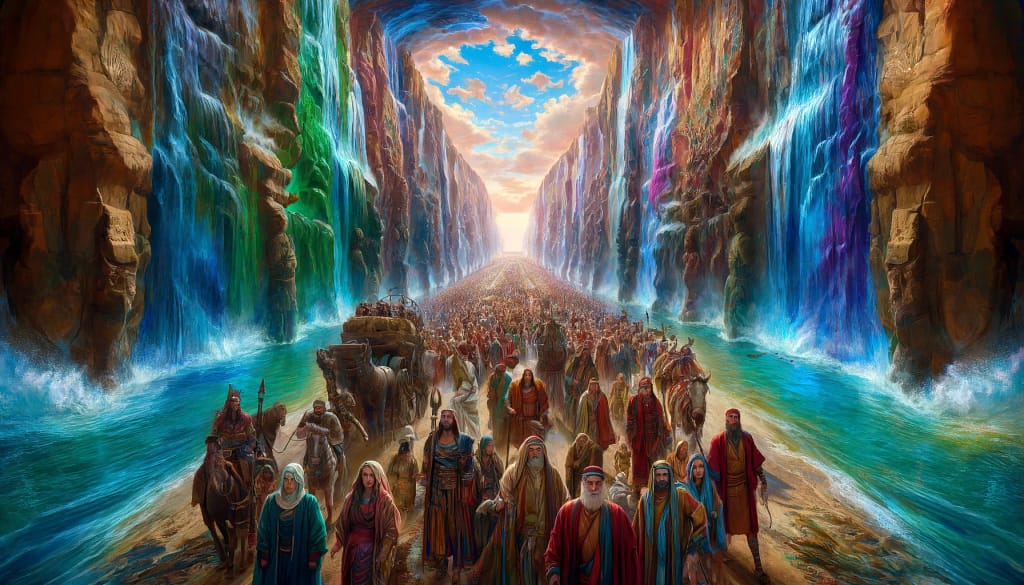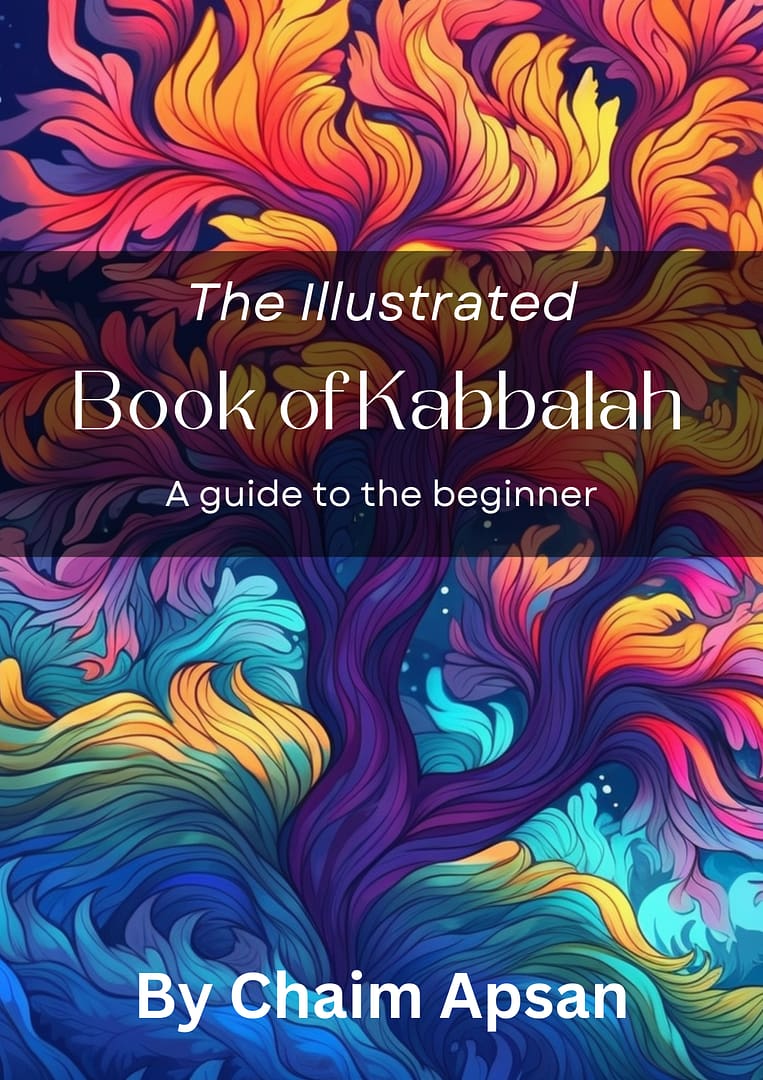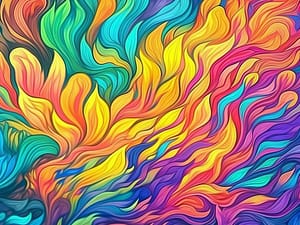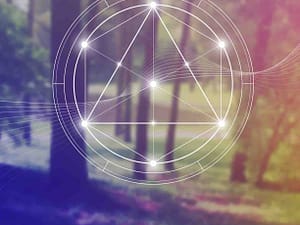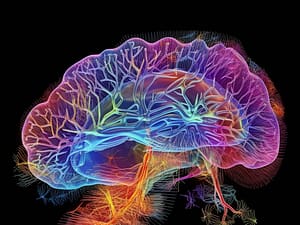The Pessach Seder offers a fascinating model for different Kabbalistic concepts which we will explore here.
Pessach is a glorious night, which even the most distant Jew joins to celebrate the Exodus from Mitzrayim (Egypt). It’s safe to say this is one of the most cherished and honored Mitzvot, as we prepare to rid ourselves of the spiritual impurities of the Chametz (ego) and enjoy some family time in royal style.
As we gather around our Seder tables this Pessach, I invite you on a journey that transcends the mere retelling of the Exodus story. After all, Kabbalah invites us into a world where each ritual during this holy night is imbued with awesome significance in the spiritual realms.
Here, every sip of wine, every crumb of matzah, and each word spoken is a Mitzvah, imbued with centuries of mystic wisdom from our sages and real Mekubalim. This unique version of the Seder opens up our vision to look beyond the physical, to explore what is behind one of our most well-kept traditions and make it a life-changing, next-level experience.
And, of course, it will all be based on the Kavanot of the Arizal and the Holy Rashash (R’ Shalom Sharabi).
But what exactly sets the Kabbalistic Seder apart, and how can we approach this deep experience?
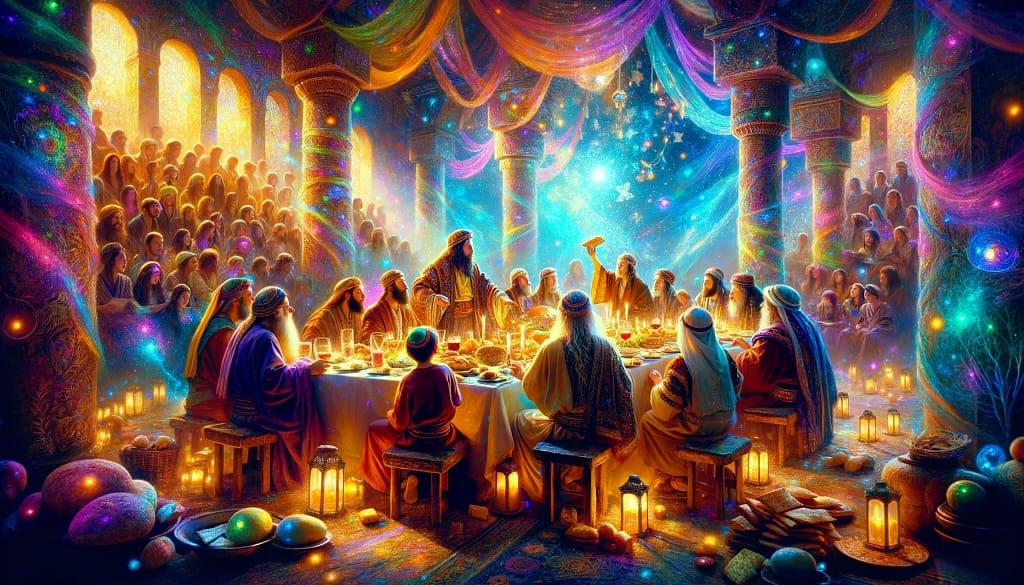
First things first, special thanks to R’ Mordechai Attia and his students who wrote the wondrous sefer Ginzei Chaim and Etz Chaim L’Motzaeihem, explaining the Kavanot in great detail with illustrations, diagrams, and tables. All the pictures below come from his Sefer (which gives free permission for anyone to print, copy, and share for non-commercial purposes).
This work of ingenuity is hard to come by and helps the serious student learn much better.
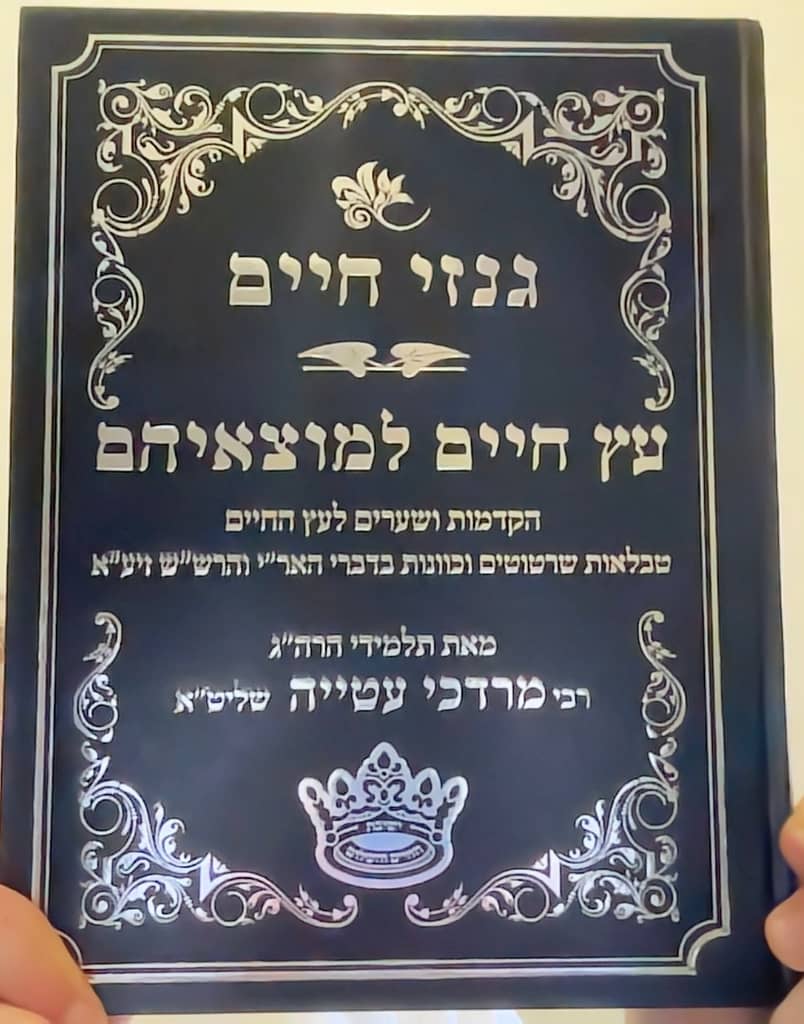
To explain the entire Pessach Seder in a single post would be impossible, but I will venture to explain some of the main Kavanot, and those interested in learning it more in-depth will learn from the books (including the one above, highly recommended).
Introduction to the Pessach Seder from a Kabbalistic standpoint
As we learned in the post about Purim, during the chag (festival) each Jew rectifies his own particular 5 Partzufim (spiritual systems) of A”K (Adam Kadmon) and ABY”A (the 4 spiritual worlds of Atzilut, Beriyah, Yetzirah and Assiyah) of the Sephira of:
- Chesed on Pessach (but also NAHY [Netzach, Hod and Yesod] of Tiferet/Shavuot)
- Gevurah on Rosh Hashana, Sukkot, Yom Kippur and Shemini Atzeret
- Tiferet on Shavuot (also the Counting of the Omer)
- Netzach on Purim
- Hod on Chanukah
- Yesod on Tu B’Shvat
- Ateret HaYesod on Tu B’Av
- Malkhut on Tisha B’Av
This shows a little of the greatness of the work Hashem has given us. Imagine that every single Jew has a set of all these Partzufim to rectify which make up the klal of the Jewish People.
Now, Pessach is special because it is not only operating on the Sephira of Chesed, but is also the beginning of the Sephira of Tiferet (NAHY = Netzach, Hod and Yesod] which goes on through Sephirat HaOmer (CHAGAT = Chessed, Gevurah and Tiferet) and culminates in Shavuot (CHABAD = Chokhmah, Binah and Da’at).
As a little reminder, one great Chiddush that the Arizal gives is that in each and every holy day (including Yamim Tovim), the Tefila corresponds to the internal part, while the meal corresponds to the external part.
This is also true for Pessach when people often rush through Arvit to get to the Seder! But we need to have extreme concentration and heart on that Tefila since it’s the internal part of the Seder, and just as essential.
Here’s a little summary of all the steps that we will be looking at:

Second page:

Mokhin of Gadlut
Each Sephira in the list of Festivals above contains a Partzuf of Zeir Anpin (Z”A) and Nukvah (the Shekhina) that must receive its Tikkun (rectification) at the appropriate time. This is done primarily by bringing down the Mokhin D’Gadlut (expanded divine consciousness) through our Avodat Hashem, but also by bringing the Mokhin of Katnut (constricted or minor divine consciousness).
After elevating the fallen sparks and shards of vessels (the berurim) through our Avodah, the Mokhin D’Gadlut are generated and descend together with Katnut to Z”A, go to Nukvah, and then down to the lower spiritual worlds of Beriyah, Yetzirah and Assiyah and then to us.
The Mokhin we need to bring (after elevating the Berurim up) are divided into 3:
- Keter
- Chokhmah
- Binah
Keter is not in our power to bring (it comes from Hashem at the end of the cycle as a gift), so that leaves us only with Chokhmah and Binah. As we are in the Pessach Seder, this means that the Mokhin of Chokhmah come through eating the Matzot, while those of Binah come through drinking wine.
Now, Chokhmah and Binah are also divided into 4 each (Chokhmah, Binah, Chassadim of Da’at and Gevurot of Da’at), corresponding to each of the 4 cups of wine and 4 Kazeitim of Matzah we are consuming. For example, the first cup of wine on Kadesh is the Chokhmah of Binah, the second is Binah of Binah, the third is Chassadim of Da’at of Binah and the fourth is Gevurot of Da’at of Binah. The same applies to the Matzach (except you change it to “of Chokhmah”).
Mokhin are complex energy constructs that follow the pattern of descent:

To explain: We are essentially bringing the Ohr (Light) of Ein Sof, to be vested in the 9 names יהוה (the Pnimi, internal) and אהיה (the Makif, external) corresponding to the 9 Sephirot (the middle column is doubled because it has a side of Chesed and a side of Gevurah), each according to its Nekud as written in Etz Chaim. If you know the position of the Sephira in the mystical Tree of Life diagram, you can readily see which one corresponds to which Nikud.
These names (with the light) are further vested in the Mokhin itself and the Levush (vestment) to then be delivered to the corresponding Kelim (vessels) of Zeir Anpin and Nukvah. So, if we are in Kadesh (the first Mokhin of Binah), you Mekaven the Ohr Ein Sof coming down to the names on the right column, entering the Mokhin and then the Kelim of ZA and Nukvah with the holy names. On the second cup, be mekaven the left column and so on. Same goes for eating Matzot, except, again, it’s from Chokhmah.
Check the table below to understand how each of the 4 cups are divided:

And here’s the table for the Matzot’s 4 Kazeitim we eat:

We will not delve too much into it, but basically, there are 2 types of Mokhin of Gadlut, Gadlut Rishon (first), and Gadlut Sheni (second), and each of them also have a full Tzelem marked by the letters ל ,צ and מ. The same happens with Katnut Rishon and Katnut Sheni.
I know it’s a lot to take in, but even if we don’t do the full kavanot of the Pessach Seder there’s still a lot to be gained by intending to be mekaven simply and letting Hashem help you. The purpose of this post is mostly to get Jews started on understanding how deep Kabbalah goes and a little bit of the greatness of our festivals.
Charosset Recipe from the Holy Arizal
Before we go on, here’s the Charosset Recipe from Rabbi Chaim Vital that the Arizal taught him from Shaar HaKavanot (HaGobi). To be honest, I had trouble understanding it since I couldn’t translate a few of the ingredients. The astute reader is welcome to clarify them for us.
“These are the things my master, the Arizal used to put in the charosset”…

3 (?) types of spices:
- Shibolet Nerd = spikenard or nard or nardin or muskroot (called Cinbol in Arabic)
- Bosheshi (?)
- Zangvilei = Ginger
- Cinnamon or cummin, not sure. In the text it’s called Cannela which is called Cummin.
7 fruits:
- Grapes
- Figs
- Pomegranate
- Dates
- Nuts
- Apples
- Pears
That said, let’s now see each of the 15 steps of the Pessach Seder in depth. Refer to the tables above to see how they correspond.
1. Kadesh (Sanctification) with wine:
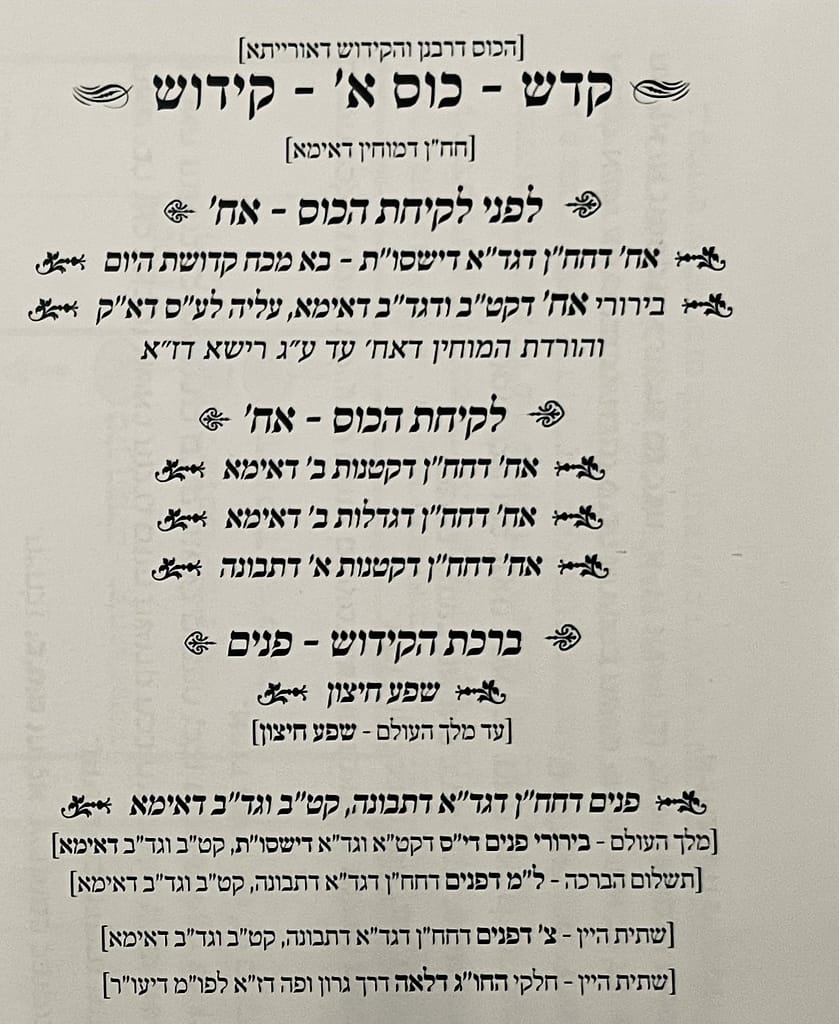
The Seder begins with the recitation of Kiddush over the first cup of wine (or grape juice), sanctifying Pessach. The Arizal explains that due to the Kedusha of the day, the first Mokhin of Gadlut Rishon of Chokhma and Binah come automatically but we still need to be Mekaven before the brachot (this is the 3rd line in the table above).
According to the Shulchan Aruch and Kitvei Ari, we only make the bracha for wine twice like the Sephardim. The reason is that with the first one, we are already elevating the Berurim of Chokhma and Binah of Binah together, and with the second one, we are elevating the Chassadim and Gevurot of Da’at of Binah.
As one may see in the last 4 lines of the picture above, the ל and מ (the Makkifim) of the Mokhin D’Gadlut are brought by the bracha itself, while the צ (the Pnimi) is brought by the action of drinking. This is a Kabbalistic principle, whenever you have a bracha and an action, the bracha brings the ל and מ while the action brings the צ.
Remember to be Mekaven that the Gadlut Rishon of the Mokhin of Chokhmah and Binah already comes with the Kedusha of the day, which is not how the order generally goes throughout the rest of the year. The Arizal teaches that this comes to show how Hashem twisted the order of descent of Mokhin to the Partzufim in order to bring about the Pessach salvation, and this sudden (and unexpected) blast of light was necessary to prevent the Sitra Achra from grabbing hold of the Israelites and preventing them to leave.
This miracle happens every year on this powerful night.
2. Urchatz (Washing)
Here we wash our hands without reciting a bracha. This act of purification prepares them for the coming Avodah though it’s done without the blessing usually said before eating Matzah because no meal is yet being consumed.

Here we are “washing” the kli pnimi (internal vessel) of the body of Z”A (the 6 Sephirot Chesed, Gevurah, Tiferet, Netzach, Hod and Yesod) by washing our hands. Be Mekaven on the 20 הי of the holy name of A”B, of which two letters stays in the source above and the rest go down. 300 total Gematria – 2 letters = 298 which is Gematria of the root of the word Rachatz (רחץ).
3. Karpas (Green Vegetable)
A green vegetable (typically parsley) is dipped in saltwater and eaten. The vegetable symbolizes the pain of the subjugation. The Arizal in Shaar HaKavanot divides the word Karpas into ס-פרך. Samech is an allusion to the 600.000 men (60 [Gematria Samech] x 10.000) which suffered backbreaking labor. Many commentators tell us that saltwater represents the tears of the Israelite slaves in Egypt.

I personally like to be Mekaven that the Karpas is a “sweetening” of the “hard work” starting with Sephirat HaOmer. “May we only eat Karpas (backbreaking work) on the Pessach Seder and that should be enough pain for us for the rest of the year.”
Here we are actually bringing down the 3 columns of the Katnut Rishon of Tevunah. Check above in the detailed table of the wine.
4. Yachatz (Breaking)
The middle matzah on the Seder plate is broken in two. The larger piece becomes the Afikoman, which is hidden and later sought after. This act symbolizes both the brokenness of the spiritual worlds which will be rectified at the end with the Afikoman.
In the Keara, the 3 Matzot from top to bottom symbolize the 3 Mokhin of Chokhmah (Kohen), Binah (Levi) and Da’at (Israel). The middle Matzah is therefore broken to represent this world (the ד representing poverty) and the world to come (the ו representing plentitude) which we hope to merit through our Avodat Hashem.
Check the above detailed table of the Matzot to see how the Letter ה is formed depending on which Matzah we are holding.
5. Maggid (Telling the Story)
This is the heart of the Seder, where the story of the Exodus from Egypt is retold. It begins with the youngest person asking the Four Questions (Mah Nishtanah), and includes the recitation of the “We were slaves to Pharaoh in Egypt” narrative, expounding on the symbols of the Seder plate, and the explanation of Passover, matzah, and maror. Each family does according to its own Minhag.
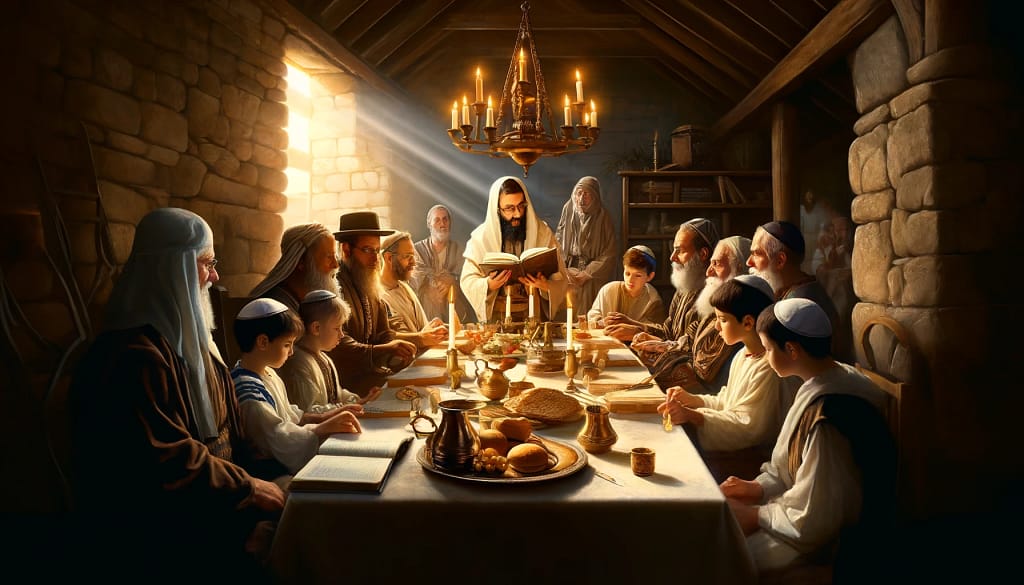
During the questions and answers of Maggid we are bringing incredibly high lights from Keter, which I suppose are not related to the Mokhin of the day, but come as extra. And as the Rabbis teach, all those who expound more is praiseworthy (and bring more lights).
We also have to fill in the second cup and hold it for V’hi Sh’amda. The second cup will be drunk after the bracha Asher Gealanu and since we already elevated the Berurim for the left column, no bracha is needed here.
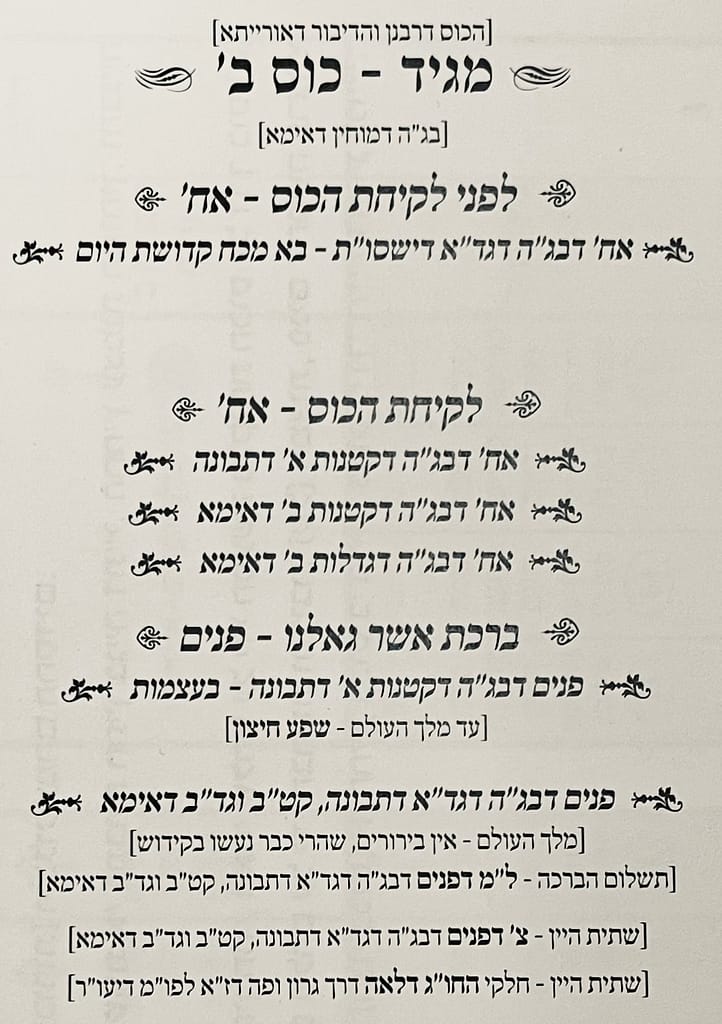
6. Rachtzah (Washing for Bread)
Participants wash their hands again, this time with a blessing, in preparation for eating the matzah.
Same Kavanah as the Urchatz, except it’s now the middle vessel (kli emtza’i).

7. Motzi (Blessing over bread/grain products) and 8. Matzah (Blessing over the Mitzvah of eating Matzah)
Now we bless for eating Matzah and for the Mitzvah of eating the Matzah. The first one is the right column of the Mokhin of Chokhmah while the second one is the left column. Therefore we take the top and middle Matzah to bless over them, while the bottom one (Mokhin of Chassadim and Gevurot of Da’at of Chokhmah) will be used for the Korech, which is a Mitzvah D’Rabbanan.
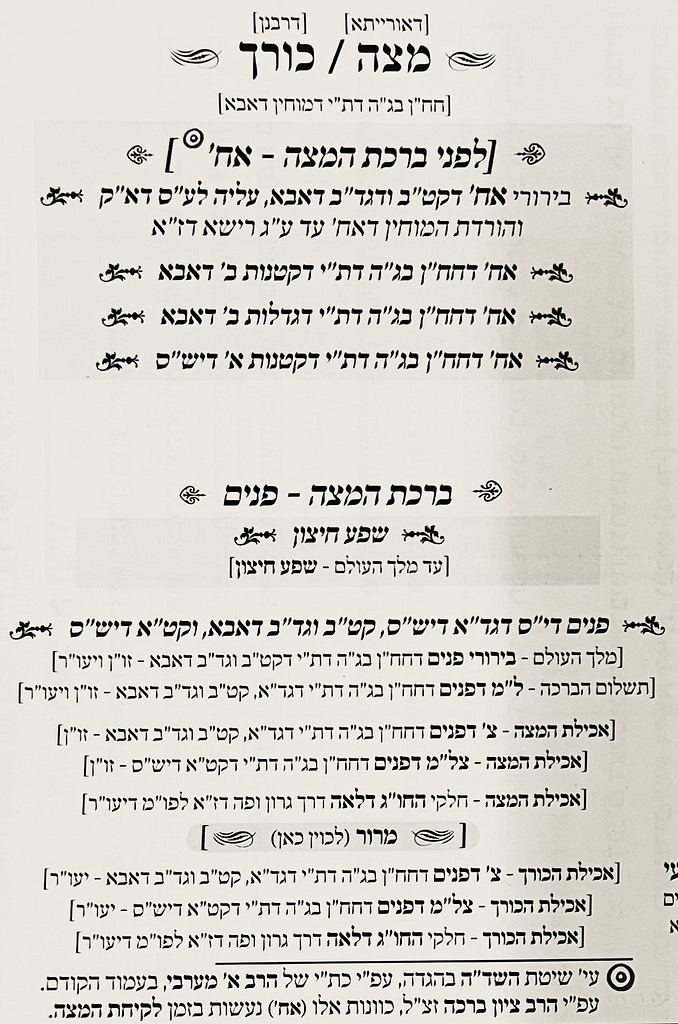
We now eat the 2 Kazeitim of matzah while reclining to the left.
9. Maror (Bitter Herbs)
Bitter herbs (typically horseradish) are eaten to remember the bitterness of slavery in Egypt.
Below are the Kavanot of the Maror:
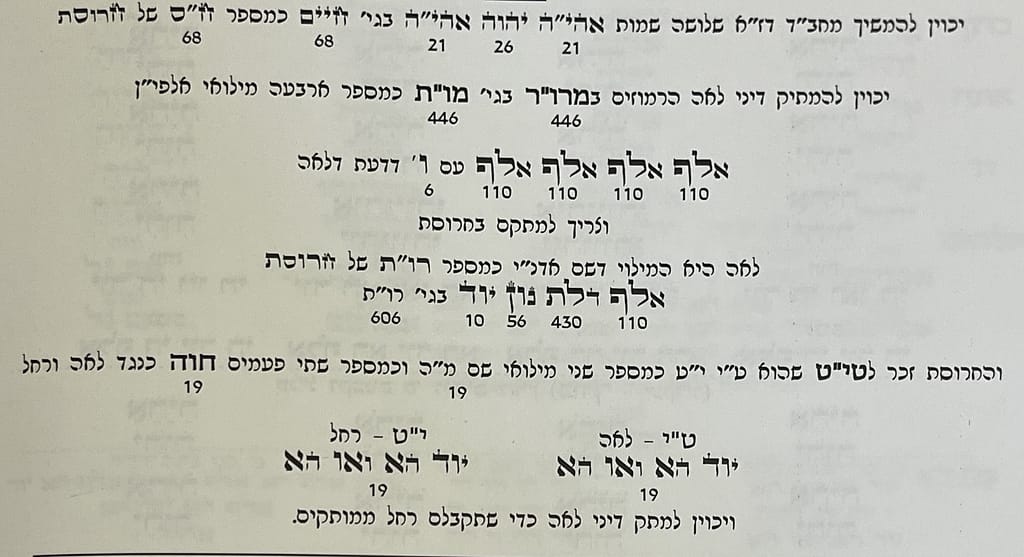
What most of us end up doing is putting Maror inside the Charosset and then shaking off the Charosset so the bitter taste doesn’t disappear. As we see in the picture above, “Maror” is Gematria “Death” (מות = מרור = 646). Personally I also like to be Mekaven that Hashem should accept us eating this Maror and consider it as “Death”. Should anyone be liable to it (chas v’shalom), may this act suffice in Hashem’s eyes.
(And, to be honest, I felt I almost died once while eating a hearty portion of the white Maror)
10. Korech (Sandwich)
A sandwich is made with matzah and maror, following the tradition of Hillel, who combined the two in the times of the Temple to fulfill the commandment to eat them together.
The Korech is the middle column of the Mokhin of Chassadim and Gevurot of Da’at of Chokhmah, and we eat it together with Charosset.
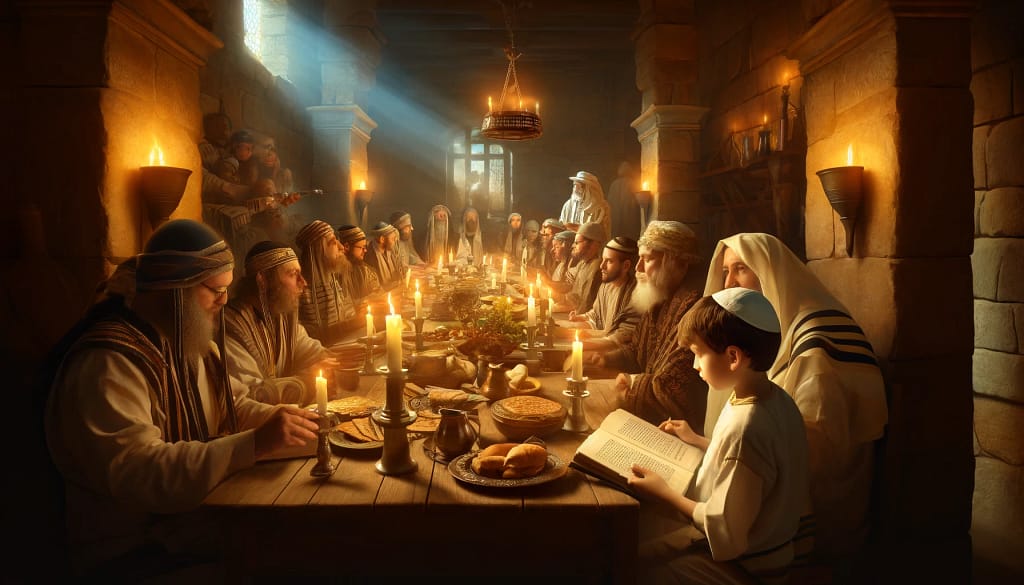
11. Shulchan Orech (The Meal)
The festive Seudah is served. Traditionally, the meal might contain a hard-boiled egg which according to the GRA is a reminder of the Beit HaMikdash, and includes various dishes. As this is Chag, it’s a great opportunity to elevate the fallen souls that were reincarnated in the food and it’s important to have meat and wine.
All the Kavanot of the meal may be used. In the Nahar Shalom’s Aggadah, they put the full Kiryat Shema to be said before Midnight, without Kavanot because the Tikkun must still be made in full despite the fact that it’s Leil Shimurim (a protected night).
12. Tzafun (The Afikoman)
The hidden piece of matzah (Afikoman) is eaten. This part of the Seder ensures that the taste of matzah is the last food eaten. Have in mind that we are enjoying a taste of Olam HaBah (the world to come), which comes only after our spiritual work.
13. Barech (Grace After Meals)
Pour the third cup even if we don’t have 3 men to do the Zimun. Same Kavanot apply as the other cups, except that we make the bracha at the end of the Birkat HaMazon, and it’s the Mokhin of Chassadim of Da’at of Binah that we bring, related to the 3rd and 4th cup.
For the Mayim Achraronim, we use the same Kavanot of the Urchatz and Rachatza, except it’s now the Kli Pnimi (internal vessel) of Zeir Anpin we are purifying.
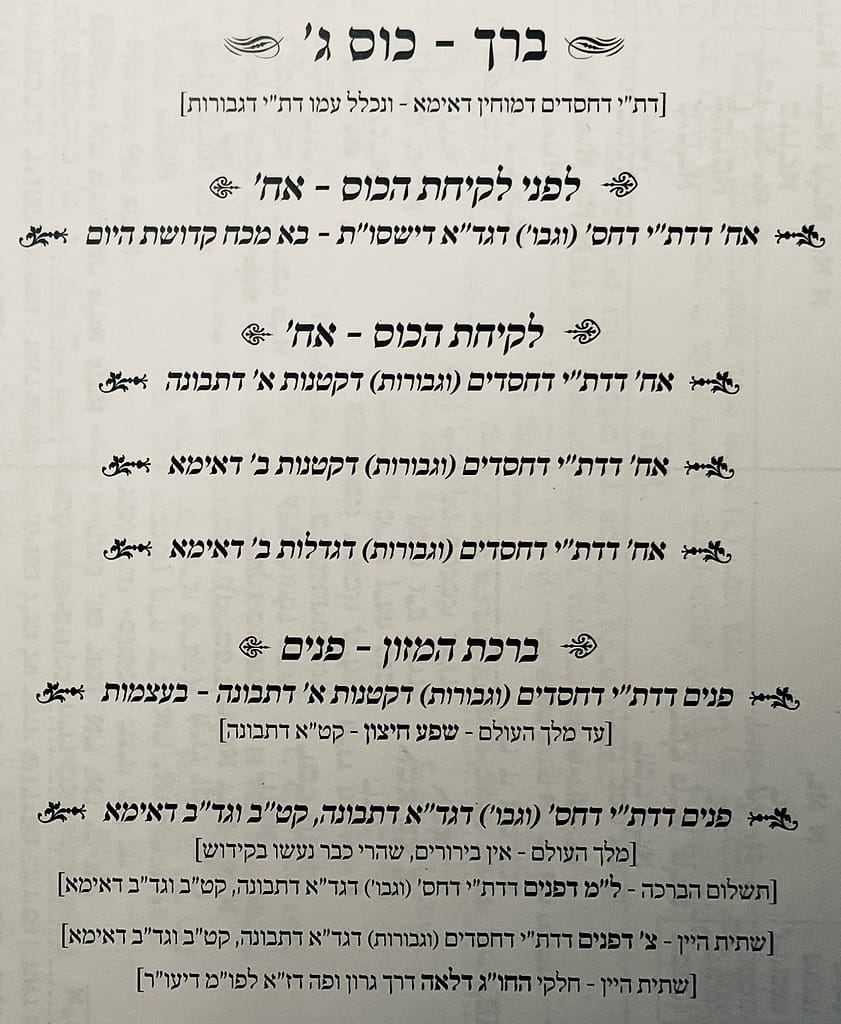
After the wine blessing, the third cup is drunk, and a fourth cup is poured, including the cup set aside for Eliyahu HaNavi.
14. Hallel (Praises)
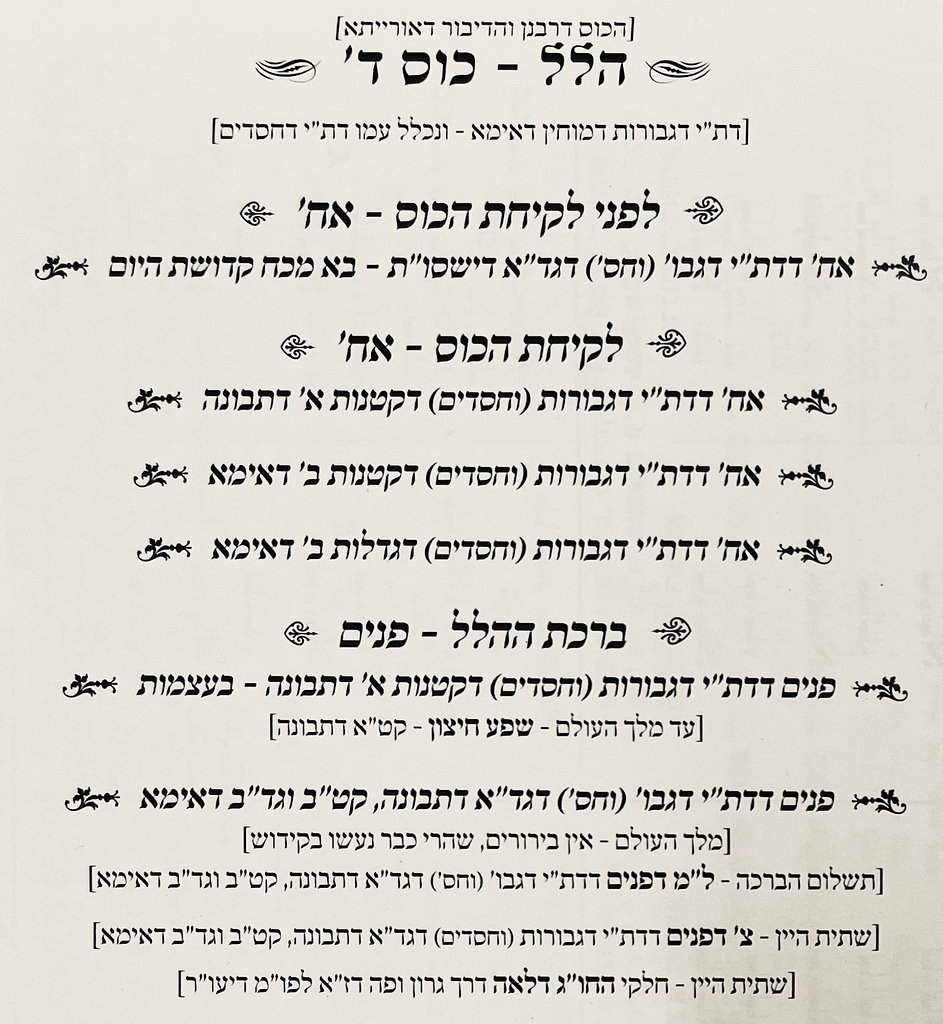
Songs of praise are recited or sung, including Psalms 113-118, celebrating the deliverance from Egypt and Hashem’s continuous protection. The fourth cup of wine is drunk at the conclusion of Hallel.
15. Nirtzah (Acceptance)
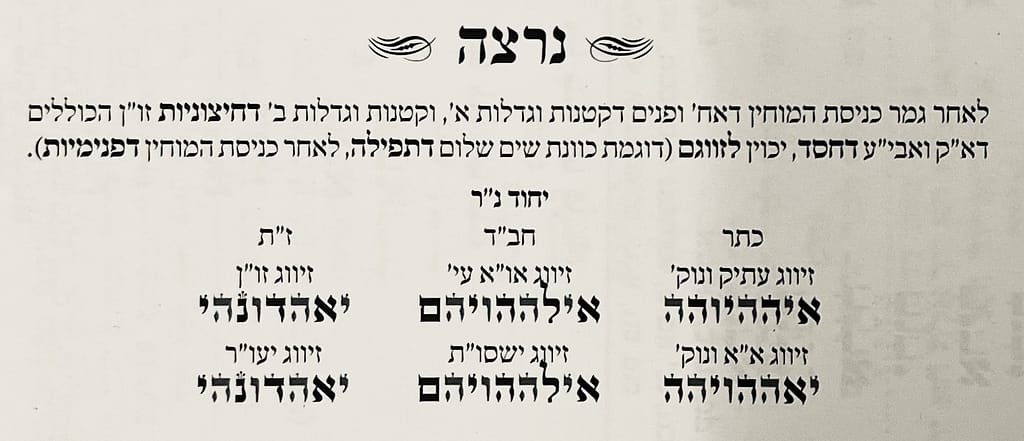
The Seder concludes with a prayer that the service be acceptable to Hashem and a hope for redemption. It ends with the phrase, “Next year in Jerusalem!” reflecting the hope for the ultimate redemption and peace.
According to the Mekubal Ha”Sadeh (R’ Shmuel Chaim Dweik HaKohen) here we should also be Mekaven that the union of Zeir Anpin and Nukvah is done, just like we are mekaven every Amidah. The union is effected at Keter, at Chabad and Z”at (7 lower Sephirot) by interlacing the letters of the holy names of God.
May we merit our full Geulah (redemption) as soon as possible and our next Pessach Seder be in the Holy Temple!
